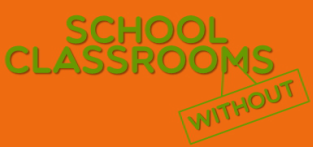System function and featuresSchool without classrooms is a comprehensive solution for modern learning. Its interior design and pedagogical model acknowledge three major human freedoms:
The idea behind the model is to allow the environment to instill scholarly rigor in all participants based upon an inspiring modular design, open spaces, flexible construction of learning centers and reinforced by the ideas of Papert’s Constructionism, Project-based learning and Intergenerational learning. To achieve our goal for the three freedoms and to maximize flexibility we apply a broad array of technologies: video streaming, audio zoning, mobile interactive whiteboards with projection facilities, video conferencing, wireless networking, tablet PC banks, magnetic work walls, a personal response system, voting devices and recording facilities. Assessment and self-assessment is also possible via an electronic voting system. It is used to help students test their understanding of concepts in response to multiple choice questions. Collaborative discussion before and after voting is an integral pedagogic approach.
We have provided interactive or conventional whiteboards, projectors with folding screens, a global PA system and local speakers; wired and wireless network for easy logging in. The design of most general learning spaces supports both tutor-led and learner-led activities. These will include presentations, discussions, collaborative project work, and information retrieval and sharing. Teaching takes place in open-plan flexible learning centers. The place for lecturing, final presentations, performances and large-group meetings is the theatre. Whenever the activity requires a wider audience, as is the case with a large group or a dispersed group, we have provided means for video streaming and video conferencing and software is used to link dispersed class members with their tutor. The cameras in the teaching spaces offer this flexibility. This blending of a real with a virtual group places the learner in a scholarly environment and provides a large number of opportunities for collaboration and building a team spirit. Every item in the space is on wheels, from the interactive whiteboard to the tables – this means the rooms can be quickly emptied and reconfigured. Folding and modular walls allow for quick configuration of any space for any purpose. |
Technology in this prototype ensures the following types of learning:
Morning registration is performed via wireless tablets; the attendance data is fed into a central database. All teaching and learning resources are available from any point of the space. The learning spaces are versatile and allow their reuse for any possible purpose: individual silent learning in a quiet place or collaborative work on a project with or without a facilitator (teacher, staff member or a senior). Each space contains a range of resources including IT, presentation and performance spaces, and seminar rooms which provide the opportunity for tutor-to-learner support sessions and for group tasks to be initiated. All areas and resources in the centers are bookable. There is a CCTV system, which serves multiple purposes:
The central atrium plays a vital part in our model. Here are a few examples of how this versatile structure can be utilized:
Another function of the proposed technology serves the purpose of sustainability of the model. The CCTV cameras show how spaces are used and to record the extent, to which rooms are occupied, which can offer savings in the long run. The same system is used for effective booking and utilization of learning spaces. |
 |
|




